When exploring the historical significance of the Havasupai Tribe, you’ll uncover a legacy rooted in resilience and cultural richness. As one of the Grand Canyon’s earliest inhabitants, their story intertwines with encounters and challenges brought by European explorers and American expansion. Despite severe land loss, the Havasupai have fought tirelessly to reclaim their ancestral lands, preserving their traditions and way of life. Curious about how they achieved this? There’s more to discover.
Key Takeaways
- The Havasupai have inhabited the Grand Canyon for over 800 years, developing advanced agricultural and irrigation techniques.
- Legal victories in the 1970s restored 185,000 acres of ancestral land, emphasizing their struggle for land rights.
- The tribe’s governance includes a democratically elected council integrating traditional practices with modern strategies.
- Tourism significantly contributes to the Havasupai economy, supporting community services and creating job opportunities.
- Language preservation initiatives ensure the continuation of the Havasupai linguistic heritage and cultural pride among future generations.
Origins and Settlement in the Grand Canyon
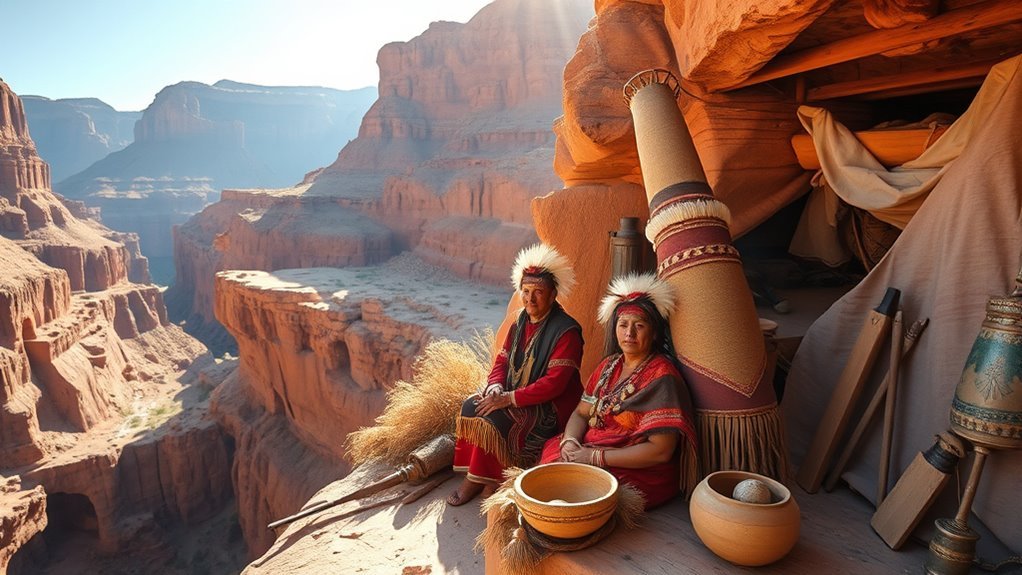
Although the Grand Canyon’s breathtaking landscapes might seem timeless, the Havasupai people, or Havasu Baaja, have called this region home for over 800 years. As “people of the blue-green waters,” they’ve thrived near Havasu Creek, utilizing the resources of their vast ancestral land.
Tribal members practiced a lifestyle of seasonal movement, covering territory from Bill Williams Mountain to the Little Colorado River. This allowed them to engage in agriculture, hunting, and gathering, deeply connecting them to the land’s rhythms.
Their presence in the Grand Canyon reflects their enduring bond with the environment. Despite later challenges, the Havasupai’s resilience guaranteed they retained vital parts of their ancestral lands, preserving their rich history and cultural identity.
Encounters With European Explorers
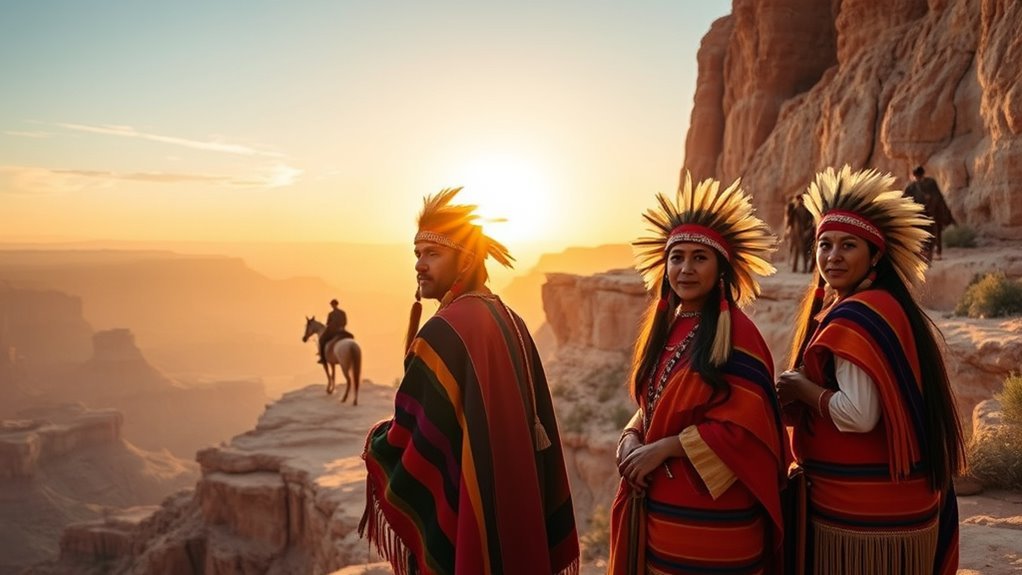
You first encounter the Havasupai’s recorded history with Europeans in 1776, when Spanish priest Francisco Garcés documents their presence, estimating about 320 individuals.
This moment sparked a series of interactions with European explorers and adventurers throughout the 19th century.
These early records set the stage for the challenges the Havasupai would face as more outsiders encroached on their land.
First European Contact
June 20, 1776, marked a pivotal moment for the Havasupai tribe as Spanish priest Francisco Garcés documented his encounter with them during his journey through the Grand Canyon.
This first European contact revealed a community living harmoniously with their environment, with about 320 individuals thriving near Havasu Creek. Garcés noted their traditional practices, including sophisticated agriculture and irrigation systems, highlighting their deep connection to the land.
However, this encounter initiated a wave of European interest in the Havasupai territory, eventually altering their way of life.
As Euro-American contact increased in the 1830s, the tribe faced significant challenges like land encroachment and resource exploitation.
These changes profoundly impacted their traditional practices, marking the beginning of a transformative period for the Havasupai.
Spanish Priest Garcés
As Spanish priest Francisco Garcés journeyed through the Grand Canyon in 1776, he documented the first recorded European encounter with the Havasupai people.
You’ll find it fascinating how Garcés observed a vibrant community of 320 Havasupai individuals. He noted their impressive agricultural practices, including the cultivation of crops along Havasu Creek.
His detailed observations provided early insights into the Havasupai lifestyle, characterized by seasonal movements between the Colorado Plateau and Havasu Canyon for hunting, gathering, and farming.
This encounter began more interactions between the Havasupai and European explorers.
Garcés’s journey highlighted the Havasupai’s resourcefulness and set the stage for significant cultural and environmental shifts in the region.
Early Documented Records
Francisco Garcés’s journey through the Grand Canyon in 1776 marked the beginning of documented encounters between the Havasupai people and European explorers. On June 20, Garcés reported meeting around 320 Havasupai, noting their impressive agricultural practices along Havasu Creek. This documented encounter highlighted their advanced irrigation systems. However, Euro-American intrusion soon followed. By the 1830s, explorers disrupted their trails, leading to eventual territorial loss.
| Year | Event |
|---|---|
| 1776 | Garcésdocumenteds Havasupai agricultural practices |
| 1830s | Increased contact with Spanish and Anglo-Americans |
| Late 1800s | Euro-American intrusion intensifies |
| 1901 | Santa Fe Railroad established |
The intrusion peaked with the Santa Fe Railroad in 1901. President Roosevelt’s 1903 visit marked a significant territorial loss, displacing many Havasupai families.
Challenges of American Expansion
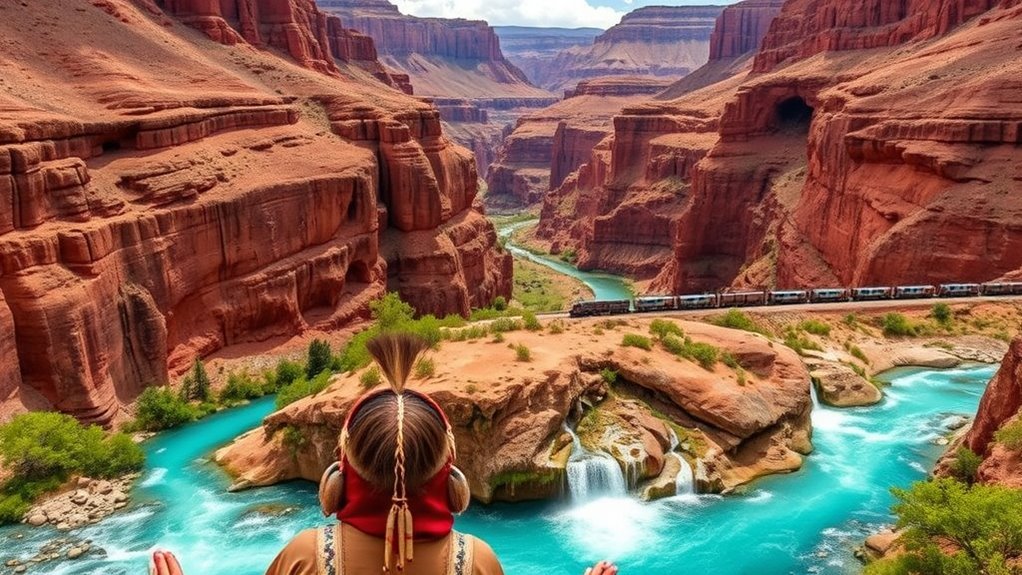
While American expansion surged across the continent, the Havasupai Tribe faced enormous challenges that reshaped their way of life.
You experienced severe land loss as American expansion encroached on your traditional territories. By 1882, your lands were reduced to just 518 acres. The establishment of the Grand Canyon National Park in 1919 further restricted access to essential resources.
This intrusion caused resource competition, leading to food shortages and a drastic population decline. By 1906, only 166 tribal members remained.
The pressures didn’t end there; cultural and social upheaval followed, exacerbated by disease and disrupted agricultural practices.
In the 1970s, legal battles brought some relief, returning 185,000 acres of ancestral land, but the struggle against expansion remains significant.
Establishment and Expansion of the Reservation
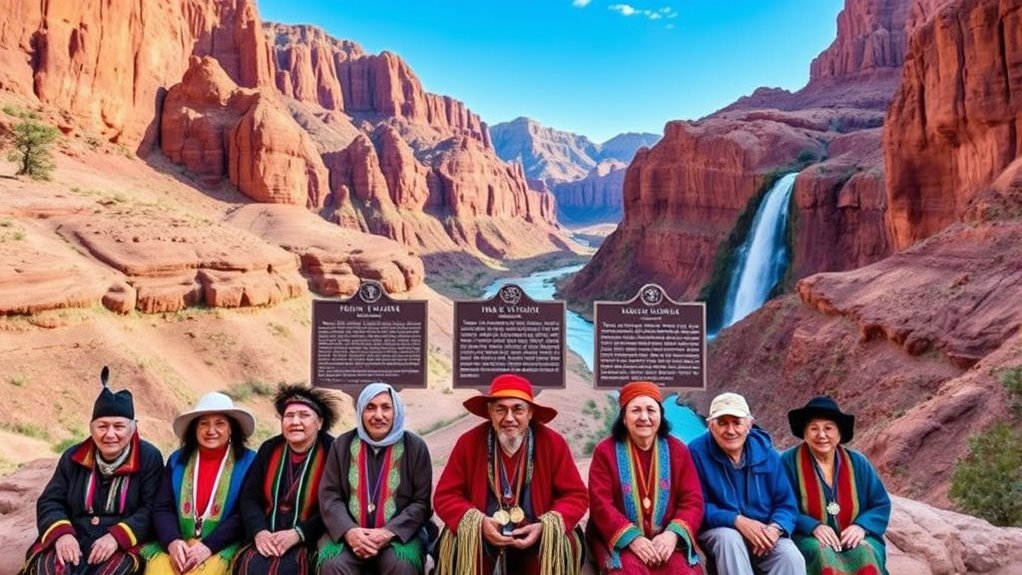
The challenges of American expansion left the Havasupai Tribe grappling with profound changes, yet resilience remained a defining trait. In June 1880, the Havasupai Reservation was established, confining you to just 518 acres in Havasu Canyon. This drastic reduction of ancestral land led to a severe population decline, with only 166 members by 1906. But you didn’t give up. Legal battles in the 1970s highlighted your determination. Congress expanded your reservation in 1975, restoring approximately 185,000 acres of land. This significant expansion marked a pivotal victory, reflecting your enduring struggle to reclaim heritage.
| Year | Event | Impact |
|---|---|---|
| 1880 | Establishment of Havasupai Reservation | Restricted to 518 acres |
| 1906 | The population recorded at 166 | Severe population decline |
| 1975 | Expansion of Reservation | Recovery of 185,000 acres of ancestral land |
Traditional Practices and Cultural Heritage

Havasupai’s seasonal agriculture practices and basketry craftsmanship are truly fascinating.
Their advanced farming techniques allowed them to cultivate crops like corn and squash, using complex irrigation systems in the Havasu Canyon.
Meanwhile, women showcased their artistry by crafting exquisite baskets, employing traditional methods passed down through generations.
Basketry and Craftsmanship
The intricate art of basketry, a skill passed down through generations of women, is at the heart of the Havasupai tribe’s cultural heritage.
The craftsmanship involved in creating these baskets reflects the Havasupai’s deep connection to their environment. Utilizing natural resources like acacia, Havasupai women master traditional twining and coiling techniques.
Baskets aren’t just household essentials but vibrant symbols of cultural identity. They play essential roles in daily life and ceremonial traditions. They’re often traded, highlighting their value within and beyond the community.
Despite the challenges of modern influences, the Havasupai tribe steadfastly preserves these basketry traditions, ensuring their cultural legacy remains vibrant and respected for future generations.
Seasonal Agriculture Practices
While basketry beautifully weaves the Havasupai’s cultural fabric, their agricultural practices demonstrate their ingenuity and relationship with the land.
Their seasonal agriculture revolves around cultivating essential crops like corn, beans, squash, melons, and pumpkins during spring and summer. The Havasupai developed advanced irrigation techniques, constructing ditches to channel water from Havasu Creek, ensuring their fields thrived despite arid conditions.
Agriculture wasn’t just a task but a communal endeavor, with families working together, emphasizing unity and collaboration. Seasonal changes dictated their approach, with agriculture in the warmer months and hunting and gathering in fall and winter.
Despite challenges from outside encroachment, their agricultural legacy remains pivotal.
- Spring and Summer Crops: Corn, beans, squash
- Irrigation Innovation: Ditches from Havasu Creek
- Communal Efforts: Families involved
- Seasonal Adaptation: Hunting and gathering in colder months
Governance and Community Leadership
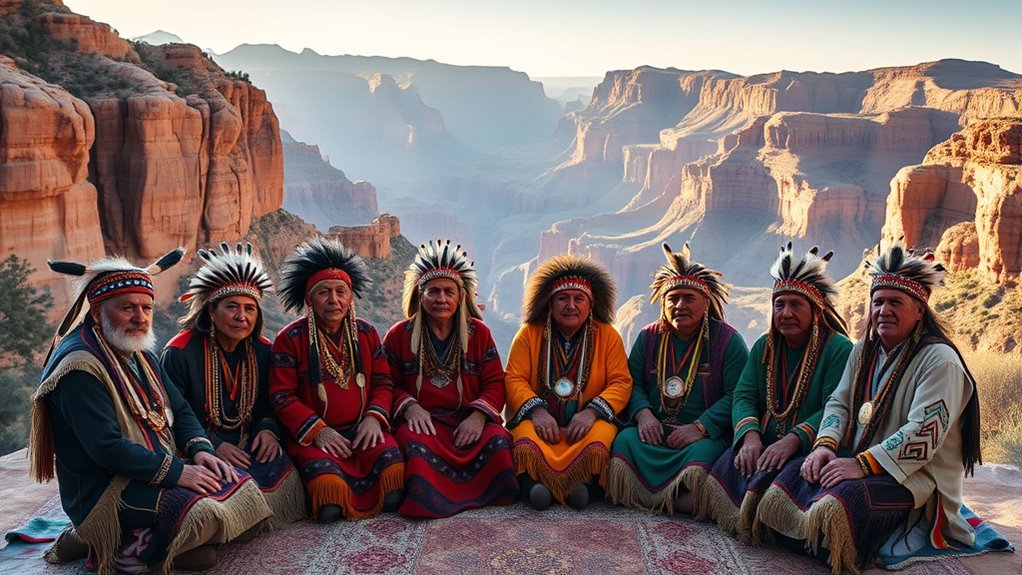
Though the Havasupai Tribe upholds its cultural traditions, it also embraces a modern governance structure with a democratically elected seven-member Tribal Council.
Every two years, you participate in elections to choose leaders who embody the tribe’s cultural identity. The council, led by Chairwoman Bernadine Jones and Vice Chairman Armando Marshall, makes decisions reflecting the tribe’s values and priorities.
They collaborate with the Bureau of Indian Affairs, which guarantees law enforcement and the protection of your community on the Havasupai Reservation. This partnership strengthens governance by blending traditional practices with contemporary strategies.
Your community benefits from a governance system that respects cultural heritage and provides essential services, including healthcare and emergency services, through the Havasupai Indian Health Service clinic.
Language and Educational Initiatives
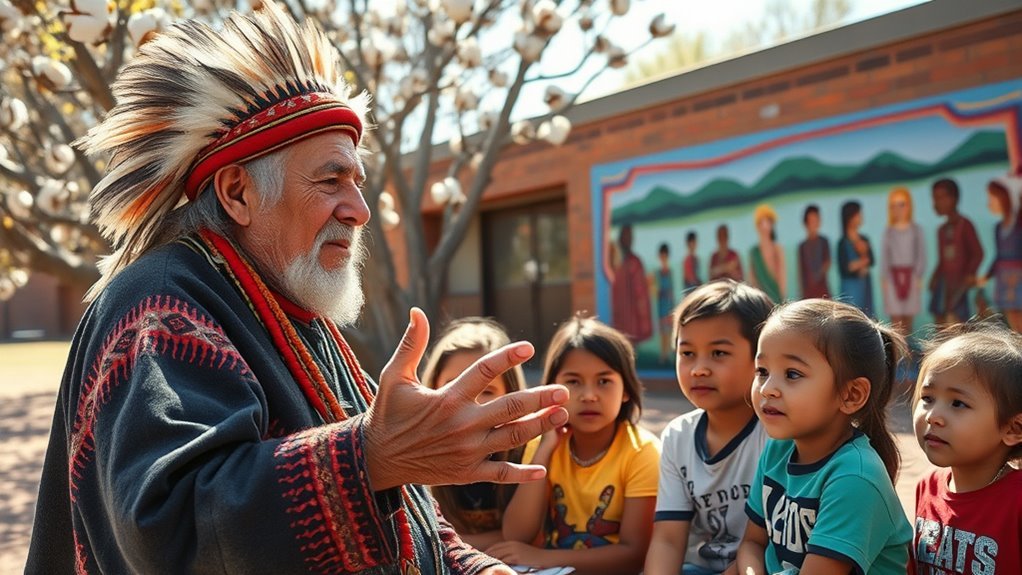
Your community’s commitment to governance is mirrored in the dedication to preserving the Havasupai language and cultural heritage.
The Havasupai Tribal Council champions bilingual education, integrating language and traditions into school curriculums. This initiative fosters cultural pride and guarantees the vitality of the Havasupai language among youth.
Collaborating with educational institutions has forged pathways for research and programs that revitalize your linguistic heritage. These partnerships also help document traditional knowledge essential for cultural preservation.
Efforts focus on creating educational materials in the Havasupai language:
- Language classes and community programs enhance fluency.
- Bilingual education promotes cultural pride.
- Partnerships with institutions advance language revitalization.
- Educational resources guarantee access to linguistic heritage.
Your dedication keeps the Havasupai language thriving.
Impact of Tourism and Modern Developments

Tourism considerably impacts the Havasupai Tribe, becoming its primary economic driver. 30,000 to 40,000 visitors flock annually to witness the breathtaking waterfalls and hiking trails. By charging entry fees, the tribe boosts its economy, supporting community services. The 8-mile Havasupai Trail to Supai Village offers stunning views and tourism-related jobs, further driving economic growth. The Havasupai Lodge and camping amenities enhance visitor experiences while preserving control over activities.
| Aspect | Impact |
|---|---|
| Visitor Entry Fees | Supports community services |
| Havasupai Trail | Provides economic boost, jobs |
| Havasupai Lodge | Enhances visitor experience |
| Cultural Renaissance | Revives traditions, boosts pride |
The Havasupai Tribal Museum celebrates the tribe’s cultural heritage, enriching tribe members and visitors.
Conclusion
You’ve journeyed through the rich history of the Havasupai Tribe, witnessing their resilience in preserving their culture amidst challenges. From their ancient settlement in the Grand Canyon to encounters with explorers and the trials of American expansion, their story is one of strength and determination. As the Havasupai continue to reclaim their lands and celebrate their traditions, they invite you to appreciate their heritage and support their ongoing efforts to protect their vibrant community for future generations.
FAQs
1. What Is the Havasupai Tribe Known For?
You’re curious about the Havasupai Tribe, renowned for its breathtaking turquoise waterfalls and deep connection to Havasu Creek. The tribe thrives on tourism, inviting you to explore its stunning landscapes and rich cultural heritage in Supai Village.
2. What is a historical fact about Havasupai Falls, Arizona?
You’re curious about Havasupai Falls in Arizona? They’ve been an essential water source for agriculture, supporting crops like corn, beans, and squash. The stunning falls draw thousands of tourists yearly, boosting the local economy.
3. What Happened to the Havasupai Tribe?
The Havasupai Tribe faced land reduction and displacement due to Euro-American expansion. However, they successfully regained much of their land through legal battles in the 1970s and thrive today by integrating tourism with cultural preservation.
4. Did the Havasupai Tribe Study Diabetes?
Yes, you’ve got it right. The Havasupai Tribe studied diabetes, focusing on genetic and lifestyle factors. However, please understand the controversy with Arizona State University over using their genetic materials without proper consent.

